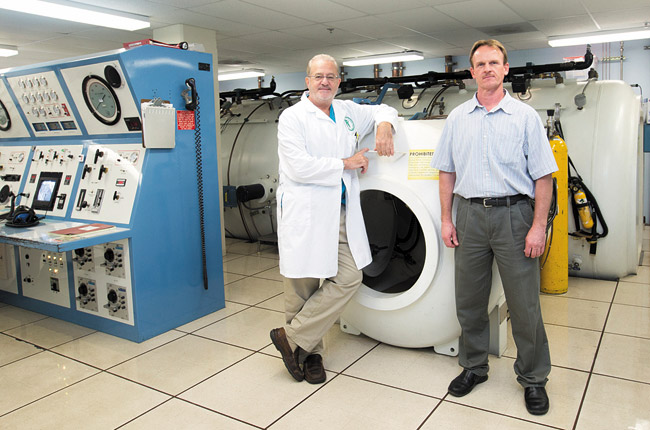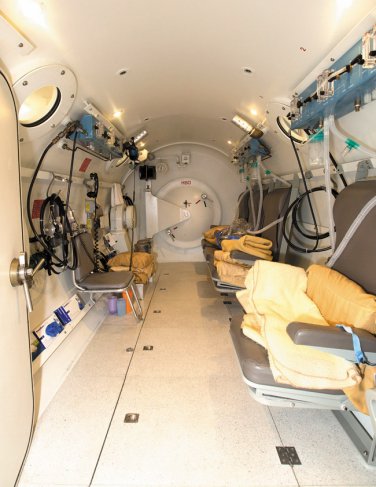Amazing Stories Of Hyperbaric Healing
The UH medical school Hyperbaric Treatment Center does miraculous things, especially with diabetics
There’s a story behind why Dr. George Macris is working at the Hyperbaric Treatment Center, run by University of Hawaii’s John A. Burns School of Medicine. A very personal story.
“My dad was a robust guy,” he says. “Back in New Jersey, they didn’t have malasadas, but they had jelly doughnuts and cheesecake. He used to lift up two cases of Coca Cola and say, ‘Look how strong I am.’ He didn’t care what anybody said, he just ate and ate and ended up with a diabetic ulcer.”
The subsequent rapid decline in his father’s health still haunts Macris. As with most diabetics who develop a diabetic ulcer, his father’s foot wounds didn’t heal, and he eventually had to have both legs amputated, dying soon thereafter at a relatively young age.
The tragic irreversibility of the circumstances is what gets to Macris, because with today’s technology he knows he could have helped his father live a heartier, longer life.
Macris is medical director at the Hyperbaric Treatment Center. Coming from a Navy background, where he worked with divers and submariners, hyperbaric medicine was a natural field of interest for Macris, especially when he discovered that treatment in a hyperbaric chamber – a pressurized chamber that uses pure oxygen as medicine – could have tacked 10 to 15 healthy years onto his father’s life. Now he’s on a mission to tackle Hawaii’s diabetic epidemic. With diabetes doubling in the past 10 years in the state, he and his crew could potentially have their hands full.
“With 120,000 diabetics, and 6 percent who are at risk, that’s about 7,200 at risk for a diabetic ulcer. Half will be dead in five years” – unless he and his team can get word out to everyone suffering with diabetic ulcers.
Divers have long have been treated for the bends in decompression chambers, but it wasn’t until the ’80s that experts realized hyper-baric facilities could help with numerous other symptoms. In fact, the bends and diabetic ulcers are just two of several major conditions the Hyperbaric Treatment Center caters to.
“Think of it as a soda bottle,” says the center’s director Kurk Jamison, explaining the physiological process involved in the bends. If you shake the bottle and open it, bubbles come showering out. “The diver does the same thing,” he says. “When they’re in the water, they take on inert gas, and when they start lessening that pressure, coming back up, depending on how fast they come back, that inert gas has to come back out of their system.”
If a bubble gets caught in their blood stream, they can die, but re-compressing them in the chamber dissolves the bubble and re-supplies oxygen to tissue that has been hypoxic, or unable to receive oxygen. That process of re-oxygenating the tissue is what makes the chamber so valuable to the center’s Wound Warrior team, allowing them to treat a variety of festering infections by supplying oxygen to necrotizing tissue and helping revitalize the surrounding venous system. Basically, our bodies need oxygen to function and oxygen under pressure allows deeper penetration, generating the process of building new cells.
Walk into the center, and with all its technological bells and whistles you might as well have entered the Starship Enterprise. A lab technician watches over a control board as the next group of patients prepares to enter the giant cylinder. Inside the chamber are seats and see-through hoods providing each participant with their own oxygen supply. The door closes and ears begin clearing to adjust to the pressure. The chamber has the capacity to go to the equivalent depth of 280 feet, but generally, they reach a “depth” of 45 feet for two hours. A person is given at least 15 treatments to see whether the compromised tissue is responding and, if so, they receive an average of 30 treatments.
Here’s the catch: With all the “bread and butter” chores a doctor manages, they either aren’t familiar with hyperbarics or it’s not the first option that comes to mind.
“If you have your leg amputated, 50 percent of people get the second leg amputated within a year. You’re dead in about five years,” says Macris. “We can stop that, but doctors are bombarded with info overload, Medicare requirements, insurance paperwork and keeping board certified, so patients need to advocate for themselves.”
Macris and his fellow doctors at the center are eager to work with physicians. His message is: Before amputating a leg, check first with the Hyperbaric Treatment Center.
Macris’ before and after shots of the center’s wound-healing capabilities are dramatic, and too graphic to post here. One shot shows a nauseating, inches-long, gaping wound with exposed tendons. In the next shot taken just a few months later, the wound has closed and is healing. And the healing effects continue even aafter the treatment is complete. Hyperbaric treatment hasn’t exploded across the globe because most individuals can’t afford it, but Hawaii patients are fortunate that the Hyperbaric Center is a state-run facility. The overwhelming statistics speak for themselves – with hyperbarics, 92 percent of potential amputation patients no longer required amputation.
Hyperbarics is being researched for treatment of strokes, traumatic brain injury and other conditions involving hypoxia, and it’s famous for speeding the healing process after plastic surgery (Michael Jackson notoriously owned his own chamber). As a certified facility, with the highest level of staff qualification and top equipment in the nation, and following standards set by Undersea & Hyperbaric Medical Society (uhms.org) guidelines, the center’s operations are safe and medically particular.
Some additional conditions the center treats include chronic bone infection. A high percentage of diabetic ulcer patients have underlying bone infections, which antibiotics alone often won’t help, but in conjunction with hyberbarics the antibiotics, which need oxygen to work, are able to do their job.
Even a fatal condition like MRSA, the dreaded flesh-eating bacteria, is put in check with hyperbarics. Macris described a 2012 patient whose hip, thigh and buttocks were so eaten away that the man was rapidly declining and unable to breathe. By the end of the first treatment, he was already complaining about the hospital food – yes, he was on his way to recovery.
Hyperbarics helps with transplants and skin grafts, and it works against gas gangrene, a fast-traveling disease, as well as carbon monoxide poisoning, if applied right away.
Another target is radiation therapy survivors. Hyperbarics soften their roughened skin tissue, which is necessary if the person requires surgery.
Macris is quick to point out that hyperbarics is not a cure-all, but that it goes hand in hand with many procedures.
His greatest focus remains on diabetics: “I saw what happened with my father – how he went from robust to a sore on his foot, to amputation. It was wheel-chair, depression, goodbye. And it’s not just him, it’s everybody. People don’t need to end up amputated, depressed, on disability and bankrupt.
“Everyone knows if they have strep throat to take antibiotics, or if they have chest pain, it’s warning of a heart attack. They just have to know that if they have an ulcer, it’s time to call the University of Hawaii’s Wound Warriors at 587-3425.”
rfournier@midweek.com







